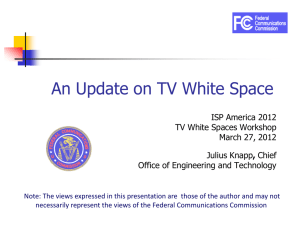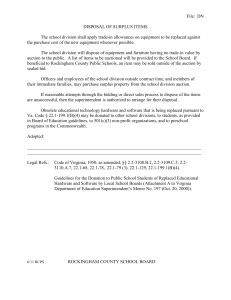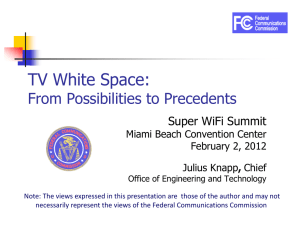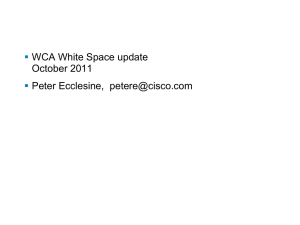Survey
advertisement
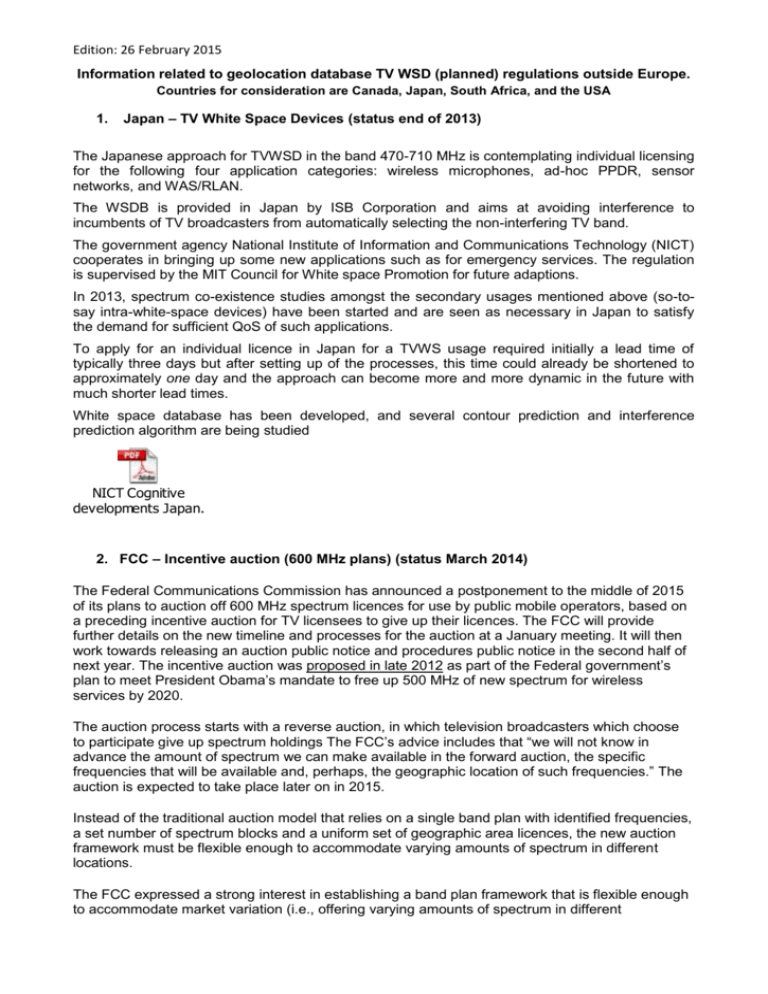
Edition: 26 February 2015 Information related to geolocation database TV WSD (planned) regulations outside Europe. Countries for consideration are Canada, Japan, South Africa, and the USA 1. Japan – TV White Space Devices (status end of 2013) The Japanese approach for TVWSD in the band 470-710 MHz is contemplating individual licensing for the following four application categories: wireless microphones, ad-hoc PPDR, sensor networks, and WAS/RLAN. The WSDB is provided in Japan by ISB Corporation and aims at avoiding interference to incumbents of TV broadcasters from automatically selecting the non-interfering TV band. The government agency National Institute of Information and Communications Technology (NICT) cooperates in bringing up some new applications such as for emergency services. The regulation is supervised by the MIT Council for White space Promotion for future adaptions. In 2013, spectrum co-existence studies amongst the secondary usages mentioned above (so-tosay intra-white-space devices) have been started and are seen as necessary in Japan to satisfy the demand for sufficient QoS of such applications. To apply for an individual licence in Japan for a TVWS usage required initially a lead time of typically three days but after setting up of the processes, this time could already be shortened to approximately one day and the approach can become more and more dynamic in the future with much shorter lead times. White space database has been developed, and several contour prediction and interference prediction algorithm are being studied NICT Cognitive developments Japan.pdf 2. FCC – Incentive auction (600 MHz plans) (status March 2014) The Federal Communications Commission has announced a postponement to the middle of 2015 of its plans to auction off 600 MHz spectrum licences for use by public mobile operators, based on a preceding incentive auction for TV licensees to give up their licences. The FCC will provide further details on the new timeline and processes for the auction at a January meeting. It will then work towards releasing an auction public notice and procedures public notice in the second half of next year. The incentive auction was proposed in late 2012 as part of the Federal government’s plan to meet President Obama’s mandate to free up 500 MHz of new spectrum for wireless services by 2020. The auction process starts with a reverse auction, in which television broadcasters which choose to participate give up spectrum holdings The FCC’s advice includes that “we will not know in advance the amount of spectrum we can make available in the forward auction, the specific frequencies that will be available and, perhaps, the geographic location of such frequencies.” The auction is expected to take place later on in 2015. Instead of the traditional auction model that relies on a single band plan with identified frequencies, a set number of spectrum blocks and a uniform set of geographic area licences, the new auction framework must be flexible enough to accommodate varying amounts of spectrum in different locations. The FCC expressed a strong interest in establishing a band plan framework that is flexible enough to accommodate market variation (i.e., offering varying amounts of spectrum in different Edition: 26 February 2015 geographic locations, depending on the spectrum recovered) to maximize the amount of spectrum re-purposed. In response to the NPRM and the 600 MHz Band Plan Supplemental Public Notice, a number of commenters raised concerns about co-channel and adjacent-channel interference between television and wireless services in nearby markets as a result of accommodating market variation. The most common approach commenters propose is to use a pre-defined separation distance between TV and mobile service areas. Commenters proposed distances that varied significantly— ranging from 100 km to 500 km—and generally provided limited technical analysis in support of these proposals (This issue is addressed in CEPT Report 29). 2.1 FCC unveils framework for the spectrum incentive auction - 600 MHz band plan (status June 2014) The Federal Communications Commission (FCC) issued on 15 May 2014 the report and order on the main rules for the broadcast TV spectrum incentive auction determining many significant issues and policy decisions. Report and Order FCC 14-50, released 2 June 2014. The report and order proposes a band plan for the 600 MHz band with specific paired uplink and downlink bands, enabling two-way communications, comprised of 5 MHz “building blocks”, consistent with the wireless industry's technical standards. The report and order allows for variation in the amount of spectrum recovered from broadcasters in different geographic areas to prevent the “least common denominator market” from limiting the quantity of spectrum that can be offered in the auction. The proposal also adopts partial economic areas (PEAs) as the licensing area for the 600 MHz band to permit entry by providers that want to offer localised wireless broadband services while also allowing providers planning to offer service on a broader geographic scale to aggregate PEAs. It sets technical and services rules akin to those governing the adjacent 700 MHz band, and requires interoperability across the whole of the new 600 MHz band. The report and order makes the 600 MHz guard band and channel 37 available for unlicensed use, thus making spectrum available for unlicensed devices nationwide. There could be 12-30 MHz of spectrum in the guard band and 6 MHz in channel 37 freed up, depending on how much spectrum broadcasters relinquish. There is likely to be a separate rulemaking proceeding shortly after the adoption of the report and order to consider changes to existing technical rules to govern the use of unlicensed devices in the 600 MHz band and channel 37 while protecting other users on the same or adjacent frequencies. 2.2. Repacking and transition TV stations opting to remain on air will be assigned new channels after the incentive auction. The proposed repacking methodology makes all reasonable efforts to preserve a station's coverage area and population served as of 22 February 2012, the date of enactment of the Spectrum Act authorising the auction. The report and order commits to making the post-auction transition “as smooth as possible”. Repurposed spectrum must be cleared no later than 39 months after repacking becomes effective. Broadcasters that successfully bid to relinquish their licences or share channels must cease operations on their pre-auction channels three months from the date they receive their auction proceeds. Those remaining on air have up to 39 months to shift to their new channels, with each station assigned a transition deadline tailored to its individual circumstances. Edition: 26 February 2015 2.3. FCC delays start of 600 MHz incentive auction to early 2016 The FCC has decided to delay the start of the 600 MHz broadcast TV spectrum incentive auction from mid-2015 to early 2016. The delay marks the second time in less than a year the FCC has pushed back the start date of the auction1 and is an indication of the both the complexity in designing the auction and the problems stemming from a legal challenge against the auction by the National Association of Broadcasters. The NAB (National Association of Broadcasters) sued the FCC in August, arguing that the agency's rules would diminish broadcasters' coverage areas and could result in a loss in viewership. One of the broadcasters' main arguments against the FCC is that the Commission has changed how it calculates TV station coverage areas, using a methodology known as OET-69, (OET = the FCC's Office of Engineering and Technology). The NAB has said it did not intend that its lawsuit would derail the auction. Under the basic auction structure, after broadcasters give up their spectrum, it will be "repacked" so that broadcasters that do not give up their spectrum can stay on the air, but typically on different frequencies. Then the FCC will conduct a traditional "forward" auction in which wireless carriers will bid for the freed spectrum; how much freed spectrum is available will depend on how much broadcasters are prepared to relinquish in return for the fees they offer to receive in order to do so.. The FCC adopted basic rules for the auction in May 2014 and then set about writing more detailed rules for how the auction would be governed. By the end of the year the Commission is expected to vote on a public notice that will propose and seek comment on the detailed directions for how the auction will be conducted, including the methodology to be used to establish opening bids for the reverse and forward auctions; how to define "impaired" markets subject to interference; and the components of determining when final bidding conditions have been met. The FCC will also consider a proposed rule-making to preserve one vacant TV channel post-auction for use by licence-exempt devices. http://www.fcc.gov/blog/incentive-auction-progress-report (24 October 2014) Other spectrum users in UHF In addition, on 30 September 2014, the FCC started a NPRM (new proposed rulemaking/ consultation) for modification of the Part 15 rules (unlicensed devices). The Commission’s Part 15 rules permit devices to operate on unused “white space” spectrum between TV stations. The Notice of Proposed Rulemaking considers changes to its existing Part 15 rules to facilitate unlicensed use of the television bands, 600 MHz Band guard bands and channel 37. Following the incentive auction, with the repacking of the television band and the repurposing of current television spectrum for wireless services, there will be fewer frequencies in the UHF band available for use by unlicensed fixed and personal/portable white space devices and wireless microphones. The proposed changes to Part 15 rules are designed to allow for more robust service and efficient spectral use in the frequency bands that are now and will continue to be allocated and assigned to broadcast television services, while continuing to protect authorised users from harmful interference. http://www.fcc.gov/document/fcc-proposes-modify-rules-unlicensed-use-tv-600-mhz-bands Docket (see views): http://apps.fcc.gov/ecfs/proceeding/view?name=14-144 FCC-14-144A1.docx The FCC comment deadline was 45 days after the date of publication. 3. Canada’s Approach to TV White Space 1 In December 2013, the FCC pushed back the start of the auction to mid-2015 from sometime in 2014 Edition: 26 February 2015 Policy decision was released in October 2012 with initial focus on geo-location database concept. Following conditions should be applied: TVWS devices permitted on a no-protection, no interference basis to licensed users in the band; LPA users require a license to receive protection from TVWS devices; No limits on number of database administrators; Spectrum sensing is permitted by policy but initial implementation of rules will focus on a geo-location database; License-exempt TVWS devices will require certification. 3.1. Industry Canada's Radio Standards Specifications RSS-222 Industry Canada published on 5 February 2015 the new RSS-222 on White Space Devices (WSDs) Link. Industry Canada's Radio Standards Specifications RSS-222 describes the various technical and operational requirements and processes to be followed when demonstrating compliance of the white space radio apparatus that is used for radiocommunication other than broadcasting. Radio Standards Specification RSS-222 sets out the requirements for the technical compliance of licence-exempt, Category I radio apparatus operating in the frequency bands 54-60 MHz, 76-88 MHz, 174-216 MHz, 470-608 MHz and 614-698 MHz, known as white space devices (WSDs). Industry Canada emphasises that the TVWS technology uses available television airwaves to deliver improved, Wi-Fi–like services in rural regions. TVWS devices will initially provide broadband Internet, similar to Wi-Fi, but with expanded coverage that exceeds traditional Wi-Fi. This move will allow these devices to be used in Canada without interfering with existing TV broadcasts. Industry Canada follows with this step the policy permitting the use of TVWS devices in 2012 with a similar approach to TVWS, The United States has taken. I. Database Approval Process Call for Applications Review of Applicants Evaluation and Testing Designation of Databases Certification of Devices II. Developmental Licensing Radiocommunication Regulations authorise the Minister to issue developmental licences. IC has a great deal of flexibility, depending on what is requested Typically short term, limited in area / frequencies Technical compatibility / interference avoidance is a key consideration Applications should be directed to any IC District Office: May take form of a letter Include specific details of what is sought No implication of ongoing tenure 4. South Africa experience 4.1 About the Trial With the support of ICASA (communications regulator of South Africa), a group of partners implemented a TVWS trial network covering ten schools in the Western Cape over a six month Edition: 26 February 2015 period during 2013. The trial partners include TENET, CSIR Meraka, e-Schools Network, WAPA and Google, with Comsol Wireless Solutions, Carlson Wireless Technologies and Neul as the vendor partners. The goals of the trial was to: Demonstrate that TVWS can be used to deliver affordable broadband and Internet services without interfering with TV reception Increase awareness of the potential for TVWS technology in South Africa and across the continent. The partners periodically updated ICASA, Sentech, the Joint Spectrum Advisory Group, broadcasters and other constituents on trial outcomes, including spectrum measurements and reported interference. The results of the trial are to be officially released at a Report Back event on November 8th, 2013 at the CSIR Building in Pretoria. 4.2 The Network The TVWS network consists of multiple base stations located at Stellenbosch University’s Faculty of Medicine and Health Sciences in Tygerburg, Cape Town, which deliver broadband Internet service to ten schools within a 10 kilometer radius. The ten schools have been pre-selected based on proximity to the base station, local IT and network support, and other connectivity requirements. Each school receives dedicated 2.5 Mbps service with failover to ADSL in order to prevent downtime during school hours. 4.3 Network Status November 8, 2013: Trial Report Back event hosted with ICASA. September 25, 2013: The CT TVWS Trial officially ends*. March 25, 2013: Network launch event hosted with ICASA. January 2013: Network equipment is being installed, configured and tested in preparation for launch. November 1 - 7, 2012: Completed pre-installations of network equipment at partner schools. October 15, 2012: 10 schools selected after extensive IT audits to meet network requirements. September 25, 2012: Selected WAPA member Comsol Wireless Solutions as the network system integrator. September 12, 2012: ICASA issues permission to Meraka and its partners to set up a TV White Space network in the Western Cape. *Although the Trial has ended, on August 28, 2013, ICASA accepted a set of recommendations by Meraka, specifically to allow the Trial network to remain operational, providing broadband to schools. 4.4 TVWS Interference Management Protocol The purpose of the trial was to establish whether interference is caused, and we have reporting mechanisms built into the trial. If someone’s TV signal is interfered with, they should report it to their TV service provider, as they normally would. All reported instances will be checked and accounted for based on the TVWS Interference Management Protocol.



